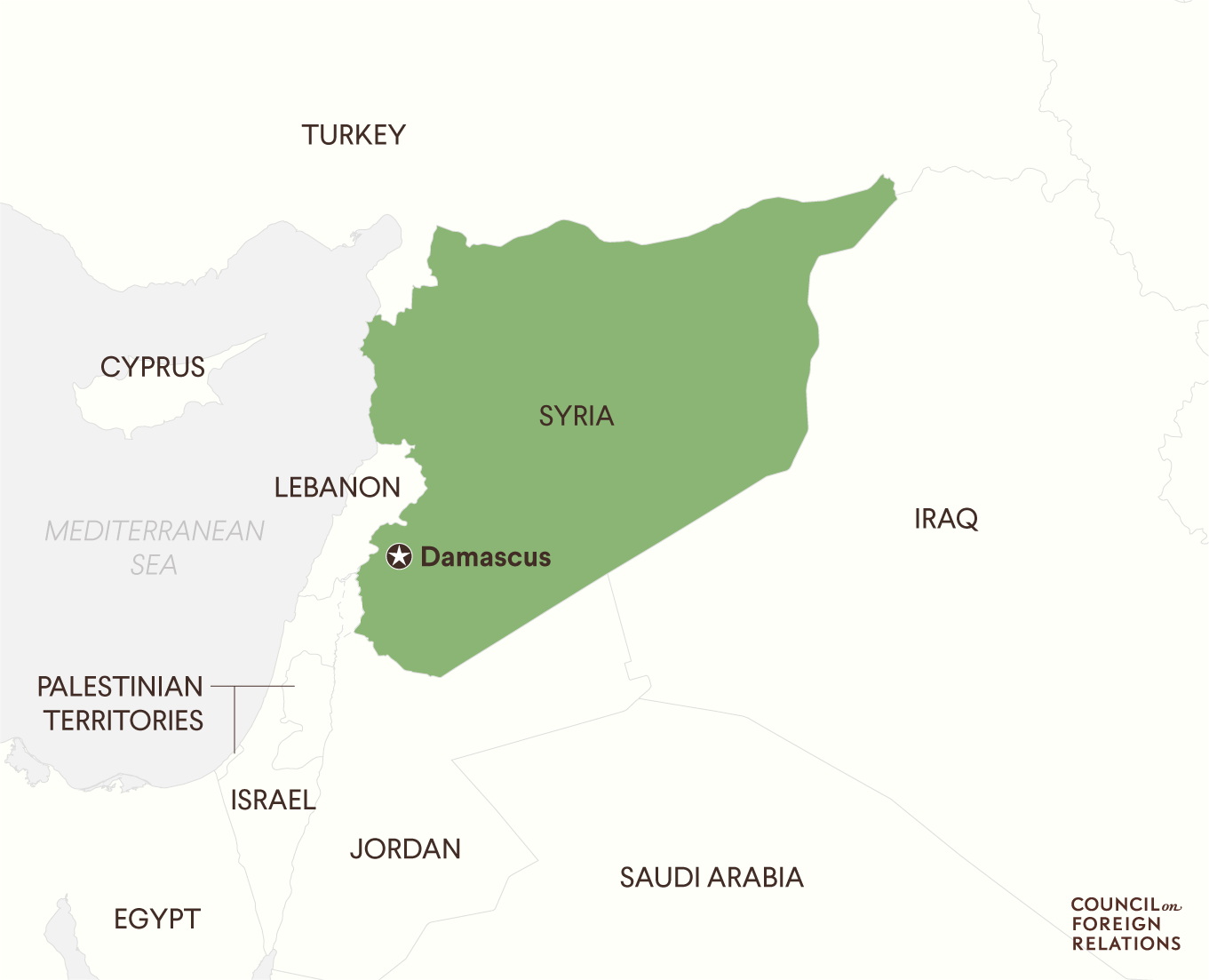 In the eight years since protesters in Syria first demonstrated against the four-decade rule of the Assad family, hundreds of thousands of Syrians have been killed and some twelve million people—more than half the country’s prewar population—have been displaced. The country has descended into an ever more complex civil war: jihadis promoting a Sunni theocracy have eclipsed opposition forces fighting for a democratic and pluralistic Syria, and regional powers have backed various local forces to advance their geopolitical interests on Syrian battlefields. The United States had been at the forefront of a coalition conducting air strikes on the self-proclaimed Islamic State, then abruptly removed forces in October 2019 ahead of the second invasion of northern Syria by Turkey, a North Atlantic Treaty Organization (NATO) ally. The Turks seek to push Kurdish forces, the United States’ main local partner in the fight against the Islamic State, from border areas. Russia too has carried out air strikes in Syria, coming to the Assad regime’s defense, while Iranian forces and their Hezbollah allies have done the same on the ground.
In the eight years since protesters in Syria first demonstrated against the four-decade rule of the Assad family, hundreds of thousands of Syrians have been killed and some twelve million people—more than half the country’s prewar population—have been displaced. The country has descended into an ever more complex civil war: jihadis promoting a Sunni theocracy have eclipsed opposition forces fighting for a democratic and pluralistic Syria, and regional powers have backed various local forces to advance their geopolitical interests on Syrian battlefields. The United States had been at the forefront of a coalition conducting air strikes on the self-proclaimed Islamic State, then abruptly removed forces in October 2019 ahead of the second invasion of northern Syria by Turkey, a North Atlantic Treaty Organization (NATO) ally. The Turks seek to push Kurdish forces, the United States’ main local partner in the fight against the Islamic State, from border areas. Russia too has carried out air strikes in Syria, coming to the Assad regime’s defense, while Iranian forces and their Hezbollah allies have done the same on the ground.
Syria likely faces years of instability to come. Assad has never been willing to negotiate his way out of power, but his continued rule is unacceptable to millions of Syrians, particularly given the barbarity civilians have faced. Meanwhile, the foreign forces on which he relies will continue to wield power. The northern part of the country appeared to enter a new chaotic phase in late 2019, with multiple international forces jostling for position and the Islamic State potentially poised for a comeback.

Hafez al-Assad is welcomed in Moscow by Soviet Premier Alexei Kosygin in 1971. Bettmann/Corbis
Assads’ Rule Breeds Discontent
Hafez al-Assad seized control from a Baathist military junta in 1970, centralizing power in the presidency. He came from the Alawi minority, a heterodox Shia sect that had long been persecuted in Syria and was elevated to privileged positions under the post–World War I French mandate.
In February 1982, Hafez al-Assad ordered the military to put down a Muslim Brotherhood uprising in the city of Hama with brute force. Syrian forces killed more than twenty-five thousand there. For the regime’s opponents, Hama would become a rallying cry in 2011. For the regime, it provided Hafez’s son and successor, Bashar, with a template for responding to dissent.
The Assads presided over a system that was not just autocratic but kleptocratic, doling out patronage to bind Syrians to the regime. As the 2011 uprising turned into civil war, many members of minority groups remained loyal to the regime, but so too did some Sunnis, fearing revenge if opposition forces were to take Damascus.
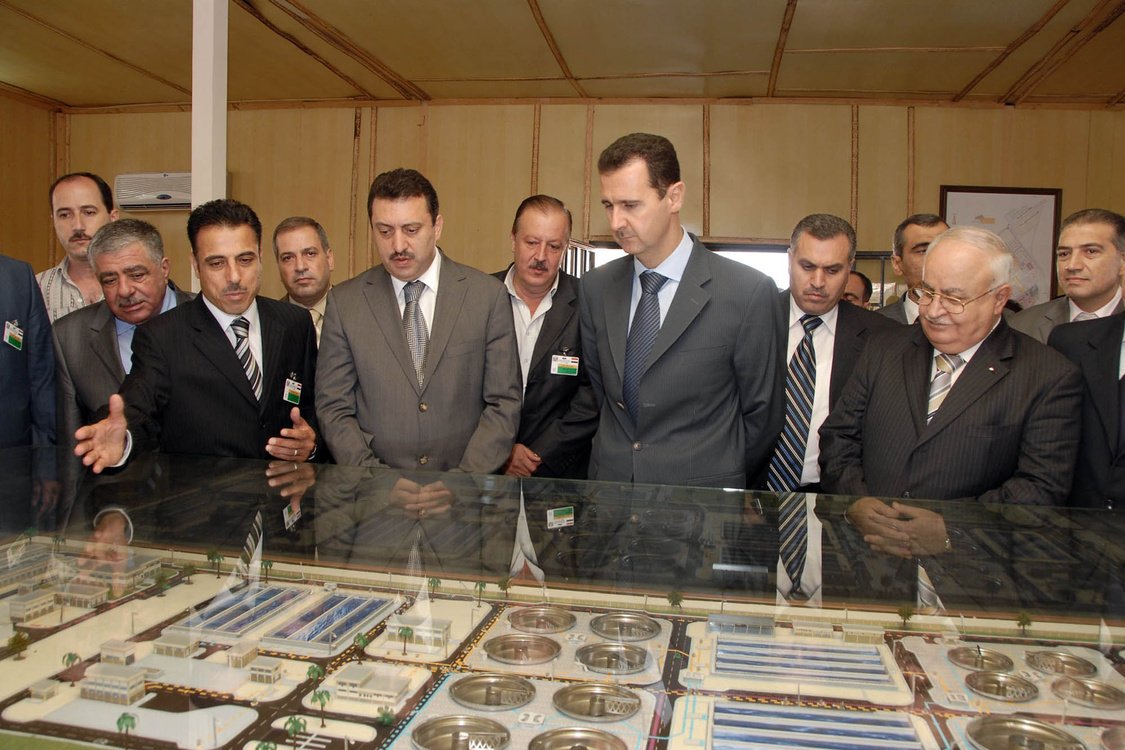
President Bashar al-Assad tours the industrial city of Hessya in 2007. SANA/AP Photo
Economic Reforms Upend Syrian Society
Bashar al-Assad succeeded his father in 2000 pledging reforms. He promised to let markets take the place of the “Arab socialism” touted by the Baathist state, upending old patronage networks. He broke up and privatized state monopolies, but the benefits were concentrated among those well-connected with the regime, while the end of subsidies and price ceilings harmed rural peasants and urban laborers. A record-setting drought from 2006 to 2010 exacerbated socioeconomic problems. Mismanaged farmland was rendered fallow and farmers migrated to cities in ever-larger numbers, causing the unemployment rate to surge.
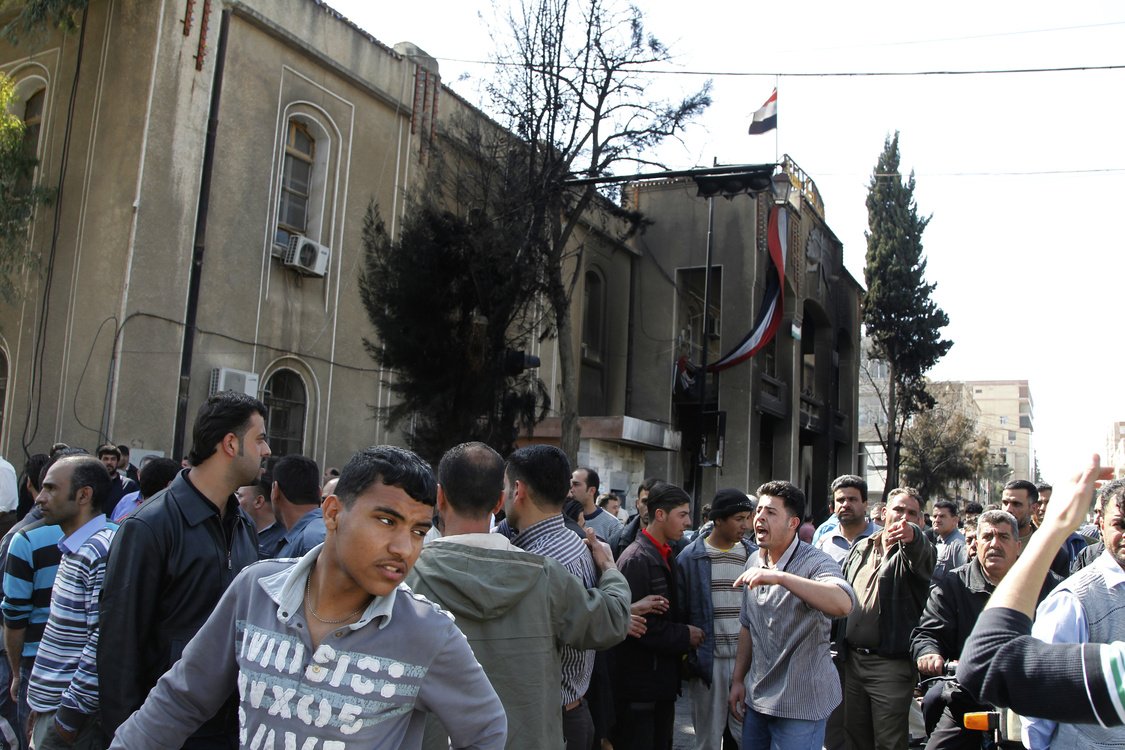
Syrians gather outside Deraa’s main courthouse, which was set on fire by demonstrators demanding freedom and an end to corruption, in March 2011. Khaled al-Hariri/Reuters
Arab Uprisings Echo Across Repressed Region
The Arab Spring began in December 2010 with the self-immolation of a Tunisian fruit vendor decrying corruption. His act prompted protests in Tunisia, and then across the Middle East and North Africa, which forced longtime strongmen in Tunisia, Egypt, and Yemen to step down. Inspired by these previously unthinkable events, fifteen boys in the southwestern city of Deraa, Syria, spray-painted on a school wall: “The people want the fall of the regime.” They were arrested and tortured. Demonstrators who rallied behind them clashed with police, and protests spread. Many protesters were calling for something more modest than regime change: the release of political prisoners, an end to the half-century-old state of emergency, greater freedoms, and an end to corruption. Unlike Tunisia’s Zine al-Abidine Ben Ali and Egypt’s Hosni Mubarak, Assad responded to protesters immediately, offering just token reforms while directing security services to put down the protests with force.

People demonstrate against the Assad regime in the besieged town of Al Qsair, near Homs, in January 2012. Alessio Romenzi/Corbis
From Protest Movement to Civil War
Anti-regime protests soon spread from Deraa to major cities such as Damascus, Hama, and Homs. Events in Deraa offered a preview of what was to come elsewhere: The Syrian army fired on unarmed protesters and carried out mass arrests, both targeting dissidents and indiscriminately sweeping up men and boys, human rights monitors reported. Torture and extrajudicial executions were frequently reported at detention centers. Then, in late April 2011, the Syrian army brought in tanks, laying siege to Deraa. The civilian death toll mounted and residents were cut off from food, water, medicine, telephones, and electricity for eleven days. Amid international condemnation, the regime offered some concessions, but it also repeated the Deraa response in other places where there were protests, at far greater length and cost, leading some regime opponents to take up arms. Local coordinating committees sprang up in villages and urban neighborhoods. Originally established to organize resistance to the regime, many of these committees would take on the roles of public administration and service provision.
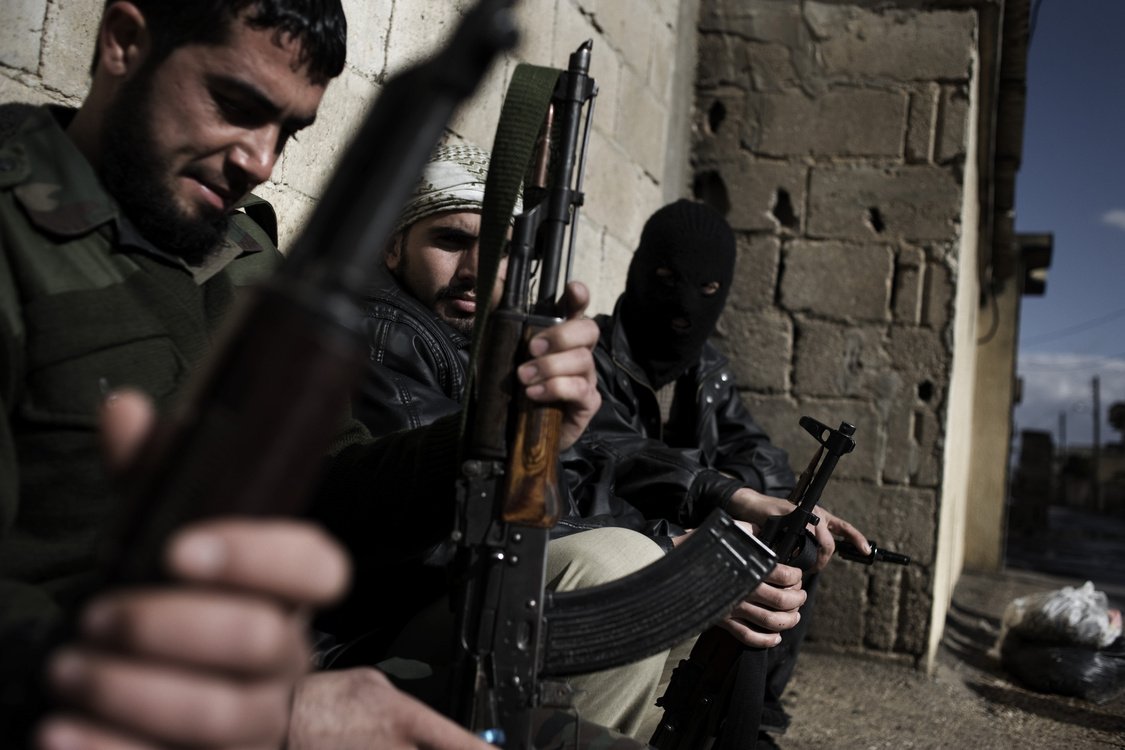
Members of the Free Syrian Army in January 2012. Alessio Romenzi/Corbis
A Disorganized Opposition Splinters
In July 2011, defectors from Assad’s army announced the formation of the Free Syrian Army (FSA), and soon after they began to receive shelter in Turkey. Yet the FSA, outgunned by the regime, struggled to bring its loose coalition under centralized command and control. FSA militias often didn’t coordinate their operations and sometimes had competing interests, reflecting their varied regional backers. With resources scarce, they preyed at times on the very populations they were charged with protecting. The FSA’s civilian counterpart was also established in summer 2011, in Istanbul. The Syrian National Coalition (SNC) claimed to be the government-in-exile of Syria, and the United States, Turkey, and Gulf Cooperation Council countries, among others, soon recognized it as “the legitimate representative of the Syrian people.” But the SNC and its successor, the National Coalition, were unable to deliver significant diplomatic or material support to the opposition, and many of the regime’s opponents within Syria accorded it little legitimacy. Rival coalitions began to proliferate, and FSA fighters drifted to Islamist brigades that, with funding and arms from Gulf donors, scored greater battlefield successes against the regime.
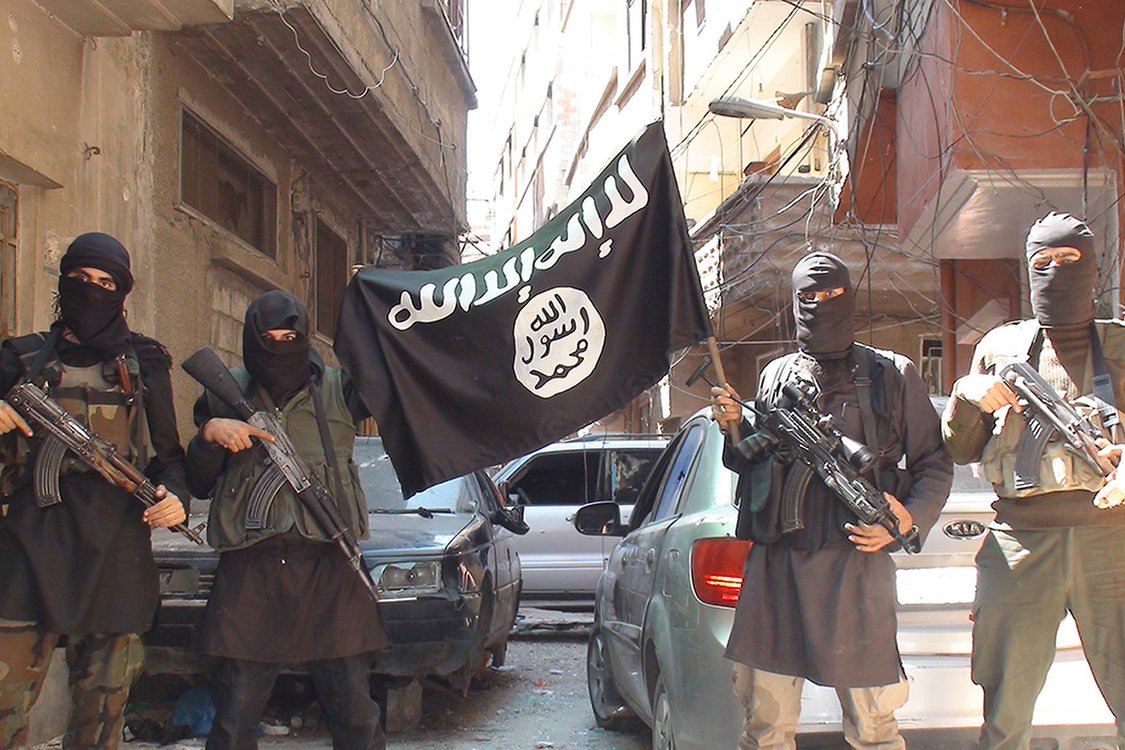
Islamic State militants pose for a photo posted online in the Yarmouk refugee camp, in the Damascus suburbs. Balkis Press/Sipa/AP Photo
Al-Qaeda and Islamic State Emerge
The regime’s torture and killing was exploited by al-Qaeda militants eager to capitalize on Syria’s chaos. In January 2012, a group called Jabhat al-Nusra announced itself as al-Qaeda’s Syrian franchise, and the following month al-Qaeda chief Ayman al-Zawahiri called for Sunnis from around the region to join a jihad against the regime. Jabhat al-Nusra gained Syrian and foreign recruits as it scored greater battlefield successes than rival opposition groups.
In April 2013, a group formed from the remnants of al-Qaeda in Iraq that called itself the Islamic State of Iraq emerged and exceeded even Jabhat al-Nusra in its brutality. In several months, its forces established control over territory spanning western Syria and eastern Iraq. The ascendance of the Islamic State and other extremists groups fed an increasingly sectarian conflict, and civilians living in the fiefs of the Islamic State—like those living under the control of the FSA and pro-regime militias—suffered abuse.
The rise of extremist groups in Syria was, in part, the regime’s own doing, as Assad wanted to present to the world a stark choice between his secular rule and a jihadi alternative. In mid-2011, the regime released hundreds of Islamist militants from prisons to discredit the rebellion. They would form extremist groups such as Ahrar al-Sham, which espoused a sectarian agenda.
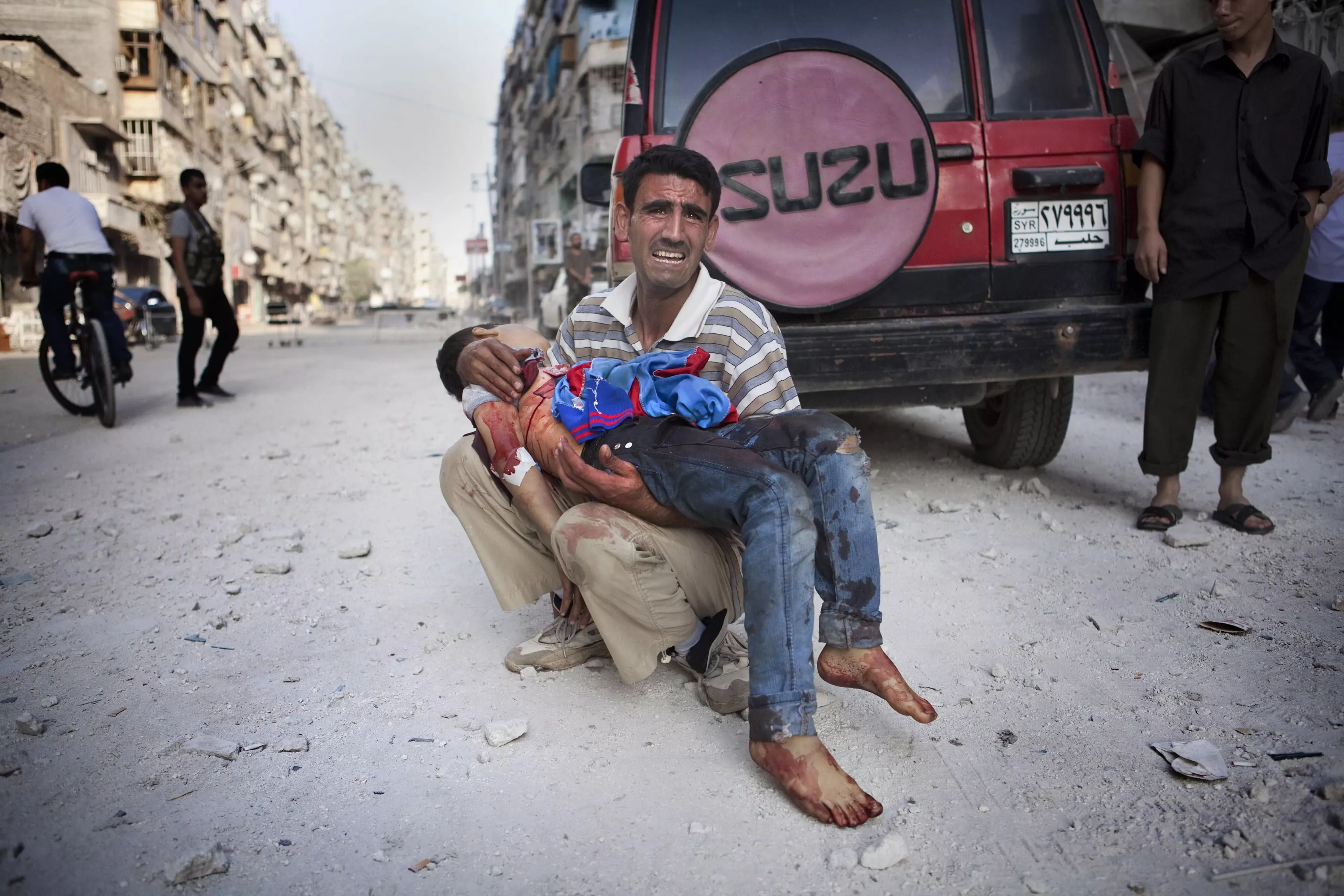
A father holds his dead child in Aleppo in October 2012. Maysun/EPA/Corbis
Civilians as Targets
Both Assad’s forces and rebel groups have regularly targeted civilians in areas outside of their control. The deaths of some 1,400 civilians from chemical weapons deployed by the Assad regime in the summer of 2013 mobilized world powers to dismantle the regime’s chemical arsenal. However, in the years since, the Syrian government has employed devastating conventional arms that have also caused massive civilian casualties.
The regime has made regular use of sieges and aerial bombardment. These collective-punishment tactics serve dual purposes, analysts say: they raise the costs of resistance to civilians so that they will pressure rebels to acquiesce, and they prevent local committees from offering a viable alternative to the regime’s governance. In 2018, the UN humanitarian agency said more than one million people lived in areas that were besieged or otherwise beyond the reach of aid.
Despite a UN Security Council resolution in 2014 aimed at securing humanitarian aid routes, aid became politicized as Assad would grant UN convoys permission to distribute food and medicine in government-held areas while denying them access to rebel-held areas, and rights advocates charged the regime with targeting medical facilities and personnel [PDF].
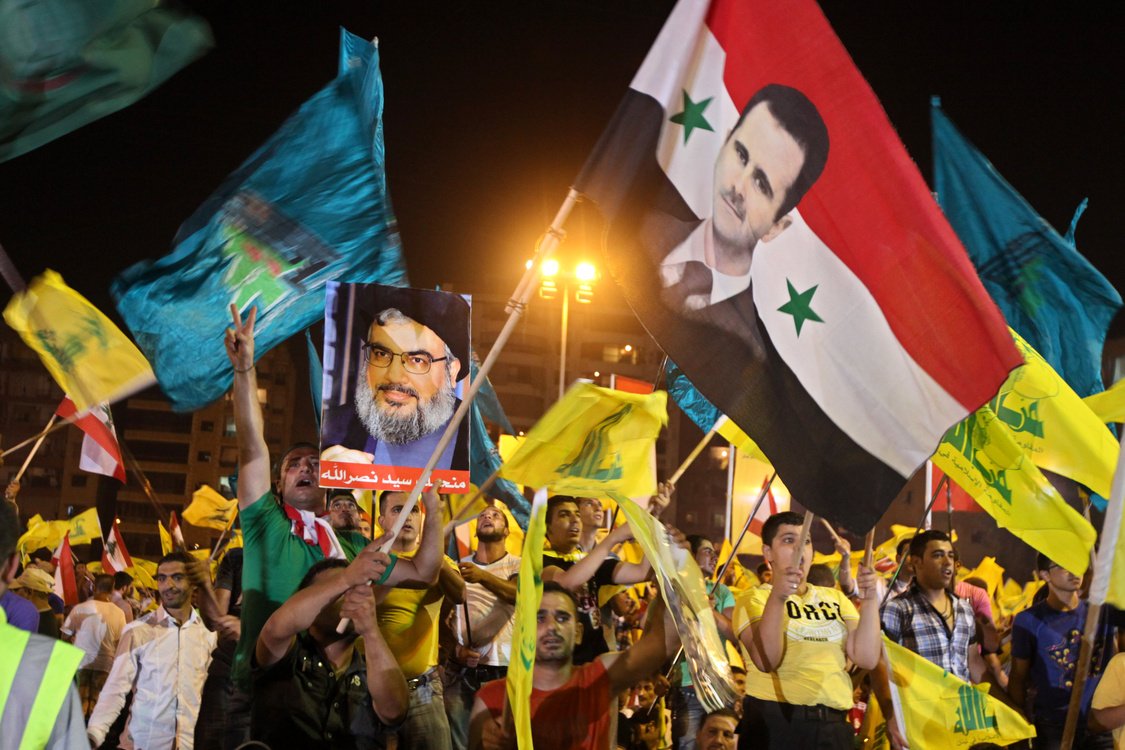
At a Hezbollah rally in the Beirut suburbs, the militant group's supporters wave flags featuring the faces of Syrian President Bashar al-Assad and Hezbollah leader Hassan Nasrallah. Bilal Hussein/AP Photo
From Domestic Rebellion to Internationalized Civil War
The deepening of Syria’s civil war made both pro- and anti-regime forces dependent on external sponsors. As major powers have deepened their involvement, Syria has become a battlefield on which the region’s geopolitical rivalries have been fought.
As mounting casualties and desertions weakened Assad’s army, the regime came to rely increasingly on Iran and Russia. Iran, a longtime ally interested in protecting a vital land route to its Lebanese proxy, Hezbollah, has invested billions in propping up the regime. Iran’s Revolutionary Guard Corps advises Assad’s army and has sustained thousands of casualties. The Iranian volunteer Basij paramilitary force and the foreign Shia militias it has rallied have suffered even more casualties.
Russia has provided Assad with critical diplomatic support. Moscow has cited what it calls an illegal intervention in Libya and the ensuing chaos there as justification for vetoing measures in the UN Security Council that would have punished the Syrian regime. Russia then entered the conflict directly in September 2015 with the deployment of its air force. Though Moscow claimed its air strikes would primarily target the Islamic State and al-Qaeda, analysts said it more often targeted other rebel groups, some backed by the United States and many intermingled with al-Qaeda’s affiliate near the front lines with the regime. This helped Assad strengthen his control of population centers along the country’s western spine.
Opposition forces, too, depend on foreign support. A rapprochement between Qatar, Saudi Arabia, and Turkey enabled the formation in March 2015 of the Army of Conquest, which comprises an array of opposition and extremist groups. The United States, too, has provided covert training and arms to opposition forces. But official foreign support for these groups has been unsteady and uncoordinated.

A YPG base in northern Syria bears signs of rocket fire from a Turkish attack. Soran Qurbani/Demotix/Corbis
The Kurdish Bid for Autonomy
Kurds have fought to consolidate a de facto autonomous territory in northern Syria, which has made them alternately friends and foes of Arab opposition groups. The Islamic State’s siege in 2014 of Kobani, a strategically located Kurdish town near the Turkish border, was a turning point. The defense of the town by the Kurdish People’s Protection Units (YPG) highlighted the militant group’s effectiveness against the Islamic State. U.S. forces aided in ousting Islamic State fighters from Kobani and continued to provide arms and air support to the YPG-led Syrian Democratic Forces (SDF).
Over time, the YPG’s priority turned to consolidating autonomous Kurdish cantons in the country’s north, a region the Kurds refer to as Rojava (Western Kurdistan). YPG fighters, interested in protecting fellow Kurds, have been accused of ethnic cleansing in mixed Arab-Kurd areas. The YPG is tied to the Turkey-based Kurdistan Workers’ Party (PKK), which Ankara and Washington have designated a terrorist organization. In August 2016, Turkey deployed its military along the Syrian border to both roll back Islamic State forces and, in tandem with Syrian Arab and Turkmen fighters, block the Kurds from linking up their two cantons in a contiguous territory. The United States had faced the dilemma of trying not to alienate either the YPG or Turkey, a NATO ally that was also a vital partner in the war against the Islamic State. But Washington eventually chose Ankara, agreeing in October 2019 to remove its troops in Syria near the Turkish border so Turkey could launch a military offensive against the Kurds.
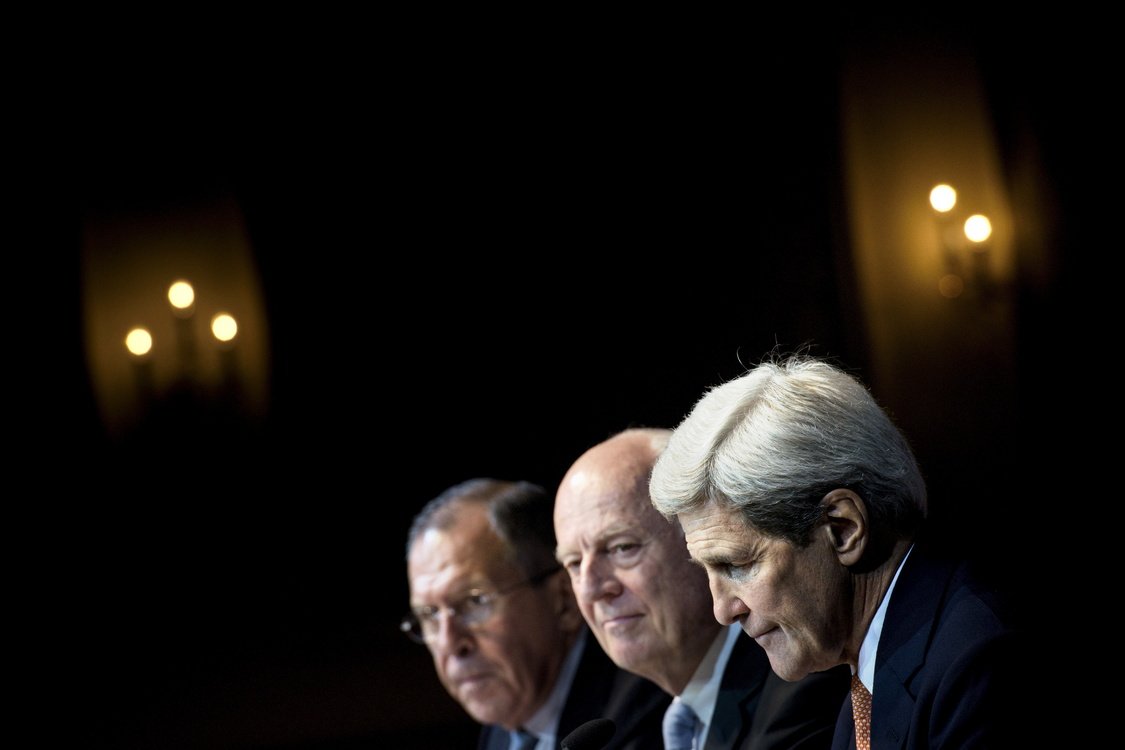
Russian Foreign Minister Sergei Lavrov, UN Special Envoy Staffan de Mistura, and U.S. Secretary of State John Kerry hold a news conference inVienna in 2015 amid frustrated efforts to find a political solution to Syria’s civil war. Brendan Smialowski/Reuters
The Diplomatic Thicket
UN-backed attempts to mediate a conflict-ending political transition in Syria have been stymied by differences among veto-wielding permanent members of the UN Security Council and other powers. Qatar, Saudi Arabia, and Turkey aligned with the United States against the Assad regime, while Iran joined Russia in backing it. Russia and China have cast multiple vetoes on Syria-related Security Council resolutions, and the threat of veto has deterred or watered down humanitarian and human rights measures, reinforcing a view of the council as toothless. A June 2012 multilateral document known as the Geneva Communiqué has become the basis for negotiations. It calls for “a Syrian-led political process,” beginning with the establishment of a transitional governing body “formed on the basis of mutual consent.” But multiple rounds of peace talks to implement these principles have yielded little. A core issue is Assad himself: he has no interest in negotiating his own political demise and retains Russia’s and Iran’s backing, while the possibility of Assad staying on in a transition is anathema to the opposition.
Because prospects for a negotiated settlement are dim, the United States has focused on counterterrorism activities while calling for de-escalation. Meanwhile, Iran, Russia, and Turkey have taken the diplomatic initiative, sidelining the UN-led process and excluding the United States. The three countries convened most recently in August 2019 for the thirteenth round of talks. But though they have agreed in principle on maintaining Syria’s territorial integrity and achieving a “lasting cease-fire,” their agreements to work through their respective local allies to de-escalate the conflict have come to naught.
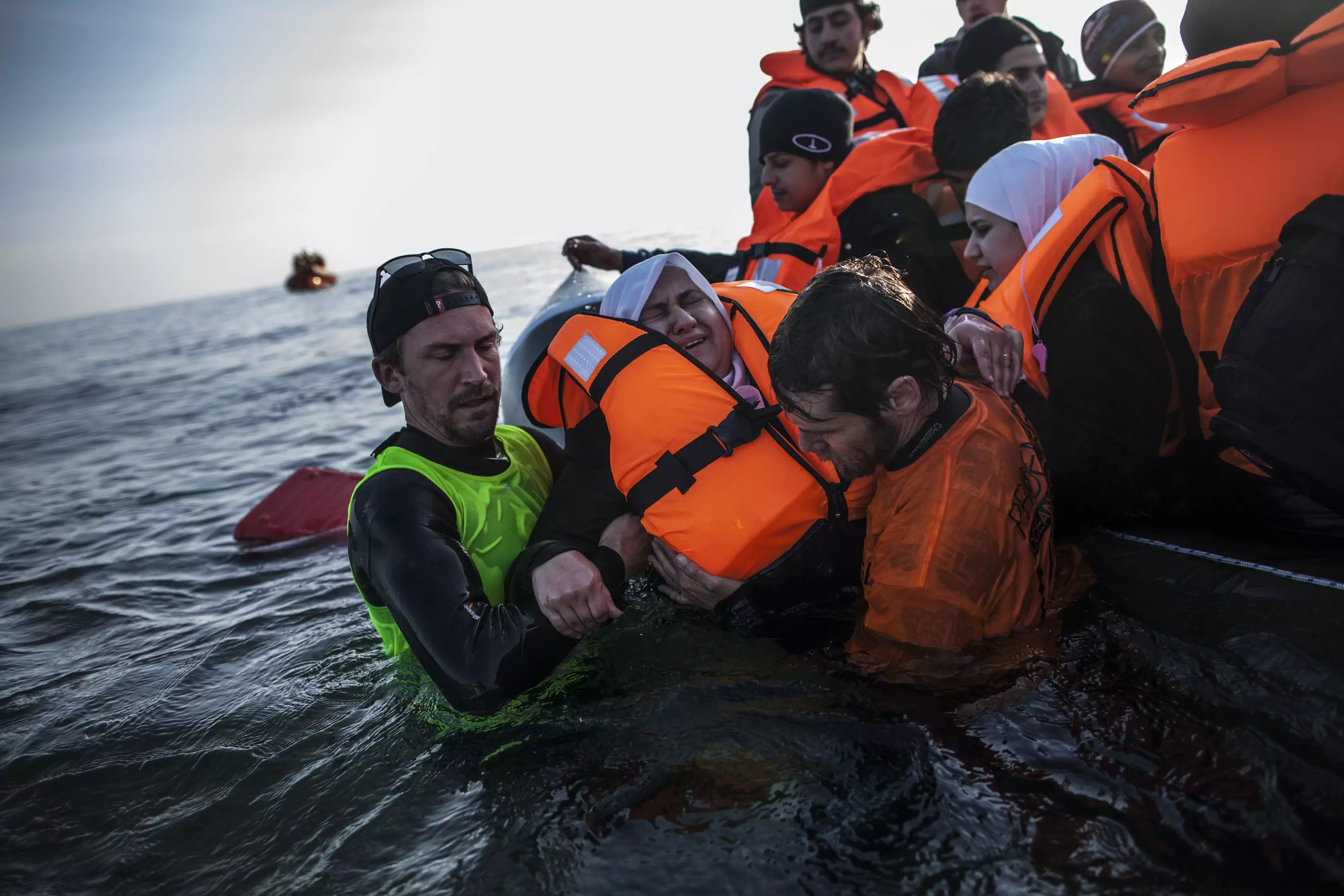
Volunteers help a Syrian refugee on the southeastern Greek island of Lesbos. Manu Brabo/AP Photo
Refugee Crisis Rattles EU
More than half of Syria’s prewar population of twenty-two million has been displaced by the violence, with more than six million displaced internally and another six million fleeing abroad. Neighboring countries have borne the heaviest burden: Lebanon, a country of only 4.5 million people, is hosting more than one million Syrians, and Jordan, with more than half a million Syrians, has begun blocking would-be refugees from crossing the border. Turkey is host to more than three million Syrians, straining government resources. With limited work and educational opportunities, and little hope that they will soon be able to return safely home, more than one million refugees have journeyed to Europe, contributing to what the United Nations has called the largest migrant and refugee crisis since World War II.
Disputes over how to settle refugees across the European Union (EU) have posed a severe challenge to the bloc, threatening to bring an end to the Schengen system of open borders on the continent and contributing to the rise of anti-immigrant, far-right parties. The EU struck an agreement with Turkey to block refugees’ northward migration in 2016, but it was jeopardized after an attempted coup against Turkish President Recep Tayyip Erdogan. He has periodically threatened to permit hundreds of thousands of migrants to cross into Europe.

Residents flee the al-Salihin nieghborhood in east Aleppo after regime troops retook the area in December 2016. George Ourfalian/AFP/Getty Images
East Aleppo Falls to Pro-Regime Forces
The regime captured the last rebel-held enclave of eastern Aleppo in December 2016 after a prolonged siege and bombardment. The city, Syria’s economic powerhouse, had been contested since 2012, and its capture marked a stark reversal of fortune for the opposition; in 2013, rebels had nearly encircled the regime-controlled western part of the city. But the campaign also demonstrated how dependent Assad has become on his foreign backers—both the Russian air force and Shiite militias—as his own forces have weakened.
Scores of civilians were massacred in the battle’s last days in what a UN spokesperson called “a complete meltdown of humanity.” With their defeat in Aleppo, rebels were isolated to northern Idlib province, parts of the south, and small enclaves around Damascus and Homs. But even with control of major population centers, Assad will have trouble reestablishing authority over a country that has been fragmented by warlords and overrun by foreign forces, and he is likely to face a persistent insurgency, analysts say.
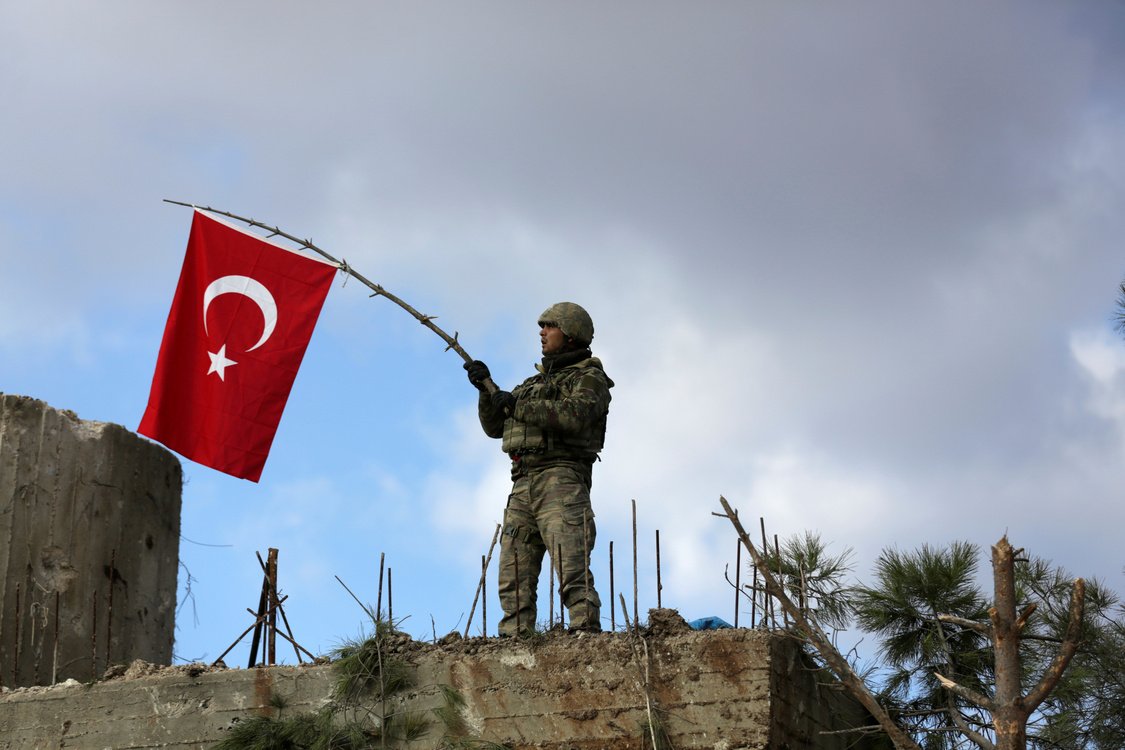
Turkish and Free Syrian Army soldiers took control of Afrin in March 2018. Khalil Ashawi/Reuters
Islamic State Decimated, Stoking New Conflicts
The U.S.-led coalition, along with the Kurdish-led SDF, has rolled back the Islamic State to a handful of small pockets. The Pentagon says the group’s territory has been reduced to about 2 percent of what it once held in an area between Iraq and Syria. By some estimates, the Islamic State in Syria has shrunk to a few thousand militants on the run, but with that came high civilian casualties, the destruction of population centers, and mass displacement.
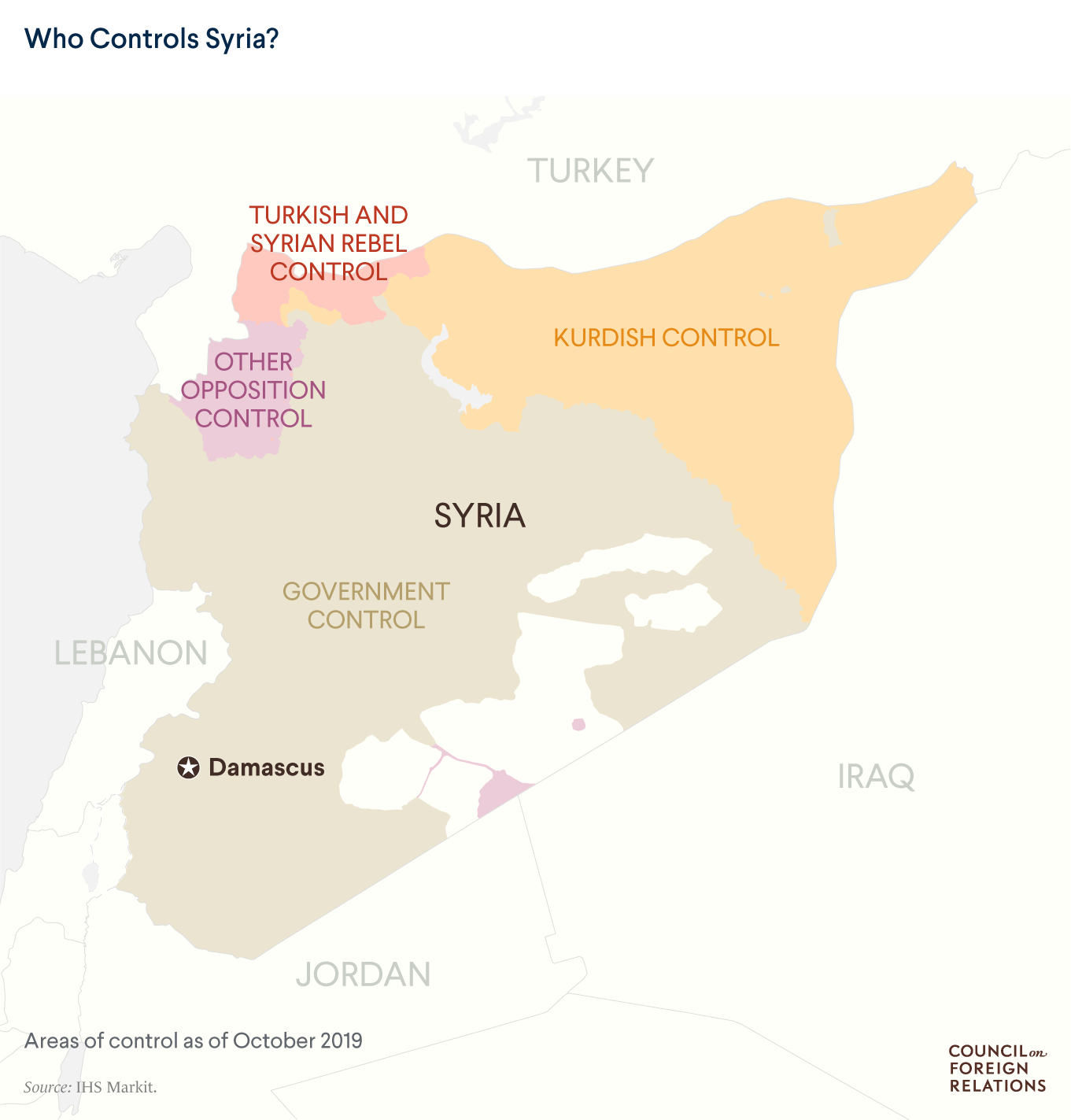
As the threat from the Islamic State diminished, simmering rivalries took on new intensity. In early 2018, Turkish forces occupied Afrin, a predominantly Kurdish enclave in northwestern Syria. Amid the Turkish escalation, SDF fighters were diverted from the fight against the Islamic State, redeploying to Afrin. Risks of military confrontation between Russia and the United States have also heightened as their warplanes report close calls and their local partners clash on the ground.

A woman stands on a street in a Kurdish town near Syria’s border with Turkey as smoke billows from tires burned to decrease visibility for Turkish warplanes. Delil Souleimand/AFP/Getty Images
Chaos in Northern Syria
The civil war entered a new stage in October 2019 after U.S. President Donald J. Trump removed the roughly one thousand U.S. troops supporting Kurdish fighters on the Syria-Turkey border. The surprise move cleared the way for Turkey’s Erdogan to launch a military operation there. Aiming to push Kurdish forces away from the border, Turkish troops and their Syrian rebel allies seized towns and villages, causing hundreds of thousands of people to flee. The SDF turned to the Syrian government for help, allowing regime soldiers to reenter areas that had been held by the Kurds for years. Russian troops also entered the region to support the Syrian government.
The Turkish incursion has drawn international condemnation, with the United States sanctioning top Turkish officials and raising tariffs on steel, but Erdogan says his troops will not back down until they establish a twenty-mile-deep buffer zone in Syria for returned refugees.
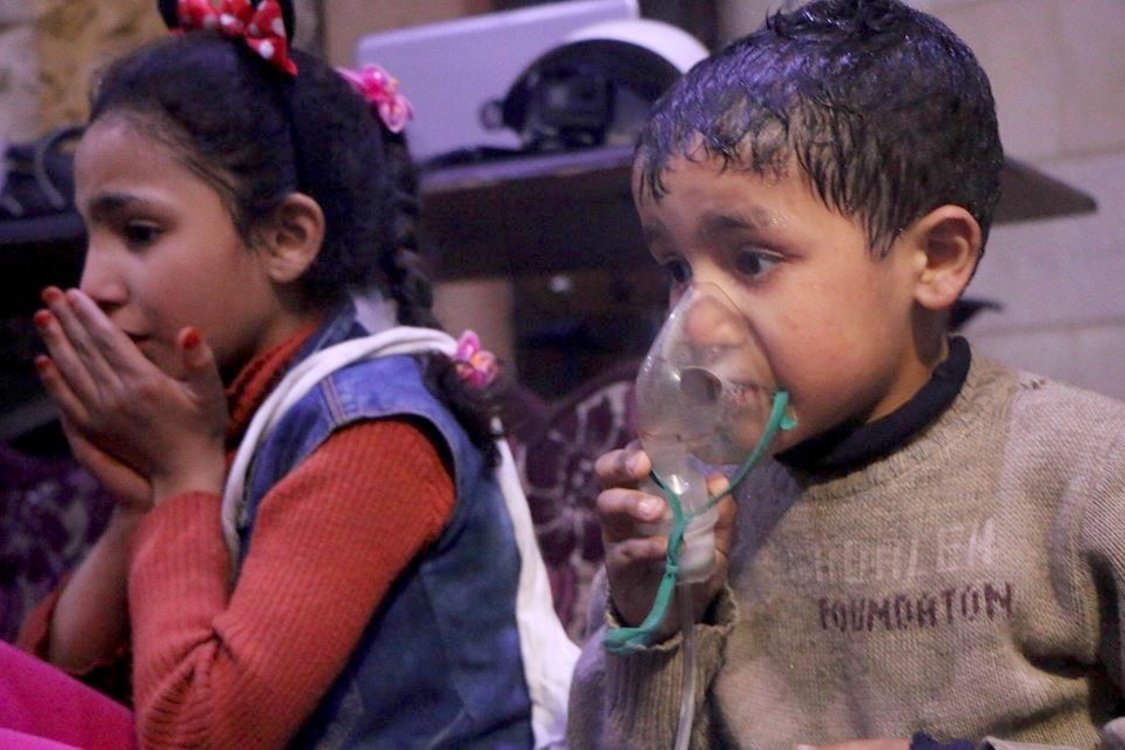
Syrian children receive medical attention after a chemical attack in Eastern Ghouta, outside Damascus, in April 2018. White Helmets/Anadolu Agency/Getty Images
Assad’s Brutal Endgame
Assad’s forces, with the assistance of his foreign backers, have besieged and bombarded the rebels’ final redoubts, imperiling hundreds of thousands of civilians. Government authorities regularly offer rebel fighters and civilians the choice of surrendering—risking conscription or arrest—or being bused north to Idlib. Idlib’s population has ballooned, even as the province, largely controlled by the al-Qaeda-linked Hayat Tahrir al-Sham, has come under attack from government troops and Russian warplanes. These attacks have continued into late 2019.
After regime forces attacked the Idlib town of Khan Sheikhoun with the nerve agent sarin in the spring of 2017, President Trump ordered a cruise-missile strike on a regime air base. Despite this, a series of chemical attacks were reported in the enclave of Eastern Ghouta, just outside Damascus, in early 2018, culminating in an apparent sarin attack in early April. In response, the United States and European allies launched air strikes on three targets. In all, researchers from the Berlin-based Global Public Policy Institute found evidence of at least 336 chemical attacks [PDF] in Syria, the majority attributed to the government.
For all of the regime’s latest successes, Assad is hardly the master of his country’s fate. Iran, Russia, and Turkey all have troops based in Syria, and Israel regularly strikes Syrian territory, targeting Iranian military infrastructure and weapons destined for Hezbollah.
No comments:
Post a Comment